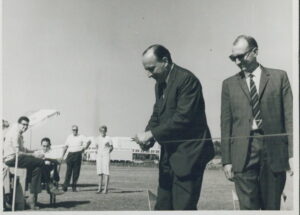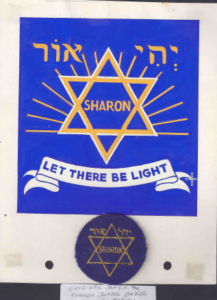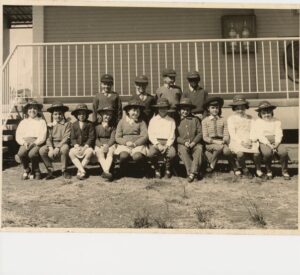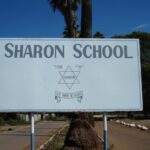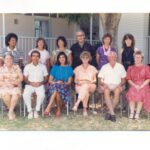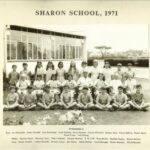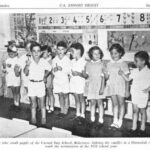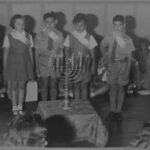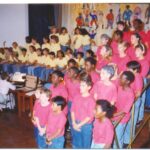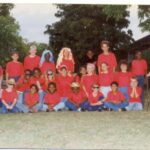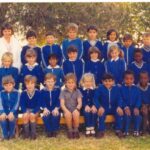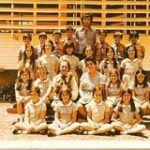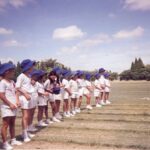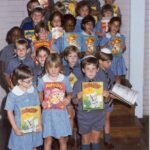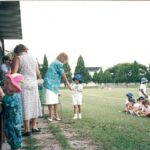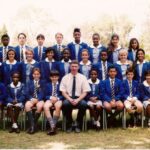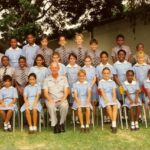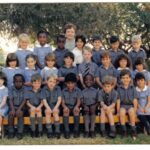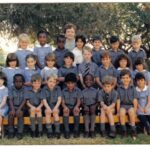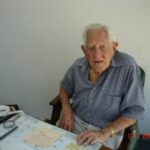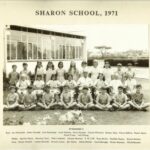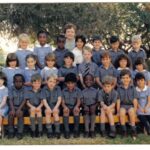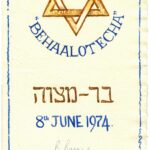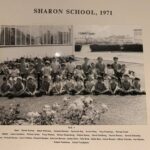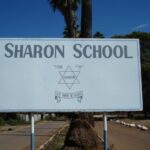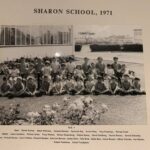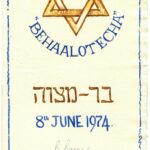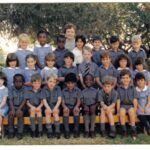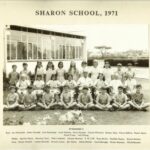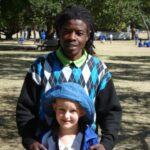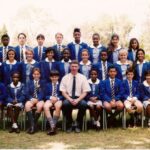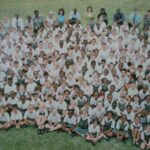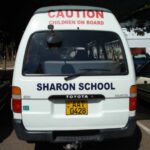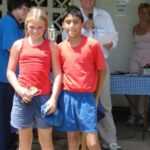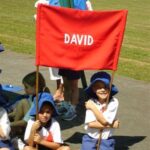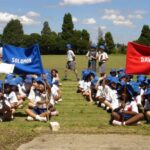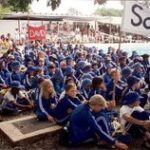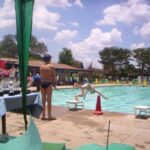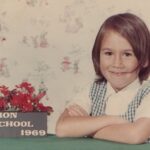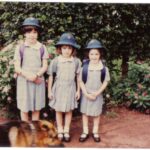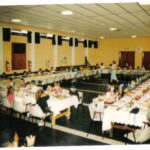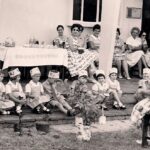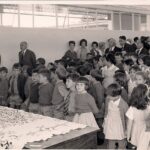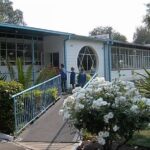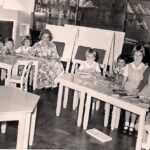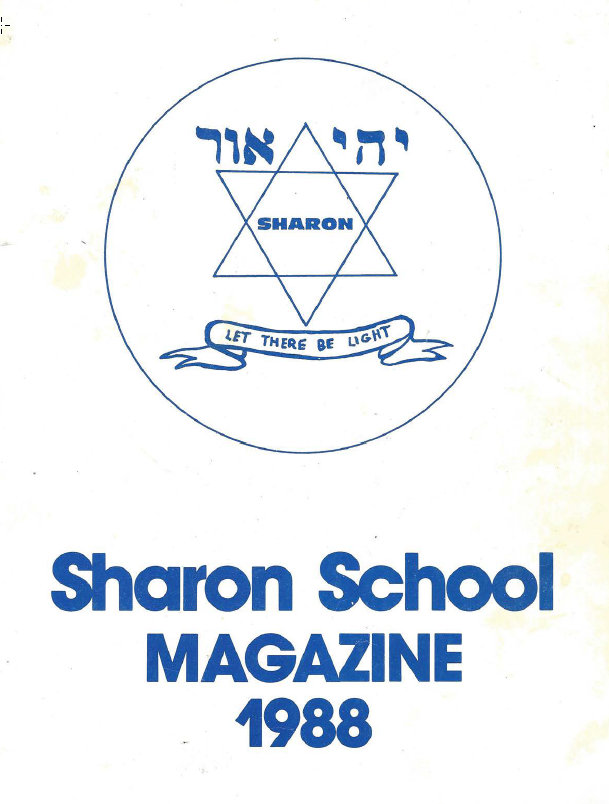Sharon school
Below is a partial gallery of pictures from the Sharon School Facebook group depicting the school’s history since the early 1960s.
This film was taken by Dave Bloom at Sharon School Speech night in 1991 – on a basic 8mm video camera and then later digitized.
This is a sample Sharon School magazine from 1988 – click on the image to download and view the PDF file.
by Marvyn Hatchuel
The Origins leading to Establishing Sharon School.
Oct 6, 2014 – An extensive scrapbook of pictures and documents collected by Marvyn Hatchuel relating to the establishment and early years of Sharon School has been added – see below.
(Written 40 years on)
When the history of Sharon School will be written, the historian or recorder will delve into the archives searching minutes , correspondence between various communal bodies and individuals, and the records provided by the school reports etc. and teachers comments. I intend to show the state of the Jewish community in Salisbury during the 1950’s and events which led up to the eventual decision to establish the school. I will rely on my memory , documents, and photos in my possession. To the best of my ability I will present this paper as factually as possible.
In 1955 I returned to live in Salisbury with my Sabra wife Aliza whom I had married in Israel two years previously, and my baby daughter Dina. We soon became involved in community affairs. Aliza had studied Occupational Therapy in New york and was deeply versed in Hebrew and Judaica. The Jewish community was divided between two congregations; the Salisbury Hebrew Congregation ( Ashkenazi) and the Sephardi Hebrew Congregation with each one having its own Nursery school, Hebrew school, and Chevra Kadisha. A smaller Reform Congregation also existed. Their only common meeting ground was within the Rhodesian Jewish Board of Deputies, and to some extent the Rhodesian Zionist Council. The Sephardic community were in the main from the Island of Rhodis and with strong ties to their origins and traditions , and many spoke Ladino. The Ashkenazi were mainly from central and eastern Europe , many being 2nd and 3rd generation Rhodesians or having come from S.Africa and other countries. Some still spoke Yiddish. A number of inter communal marriages had taken place with the spouses usually being absorbed into the Sephardic congregation. There was a general feeling of optimism in Rhodesia generated by rapid expansion in most sectors of the economy, a growing population of white immigrants with entreprenarial skills and plans for harnessing the country’s resources. The Jewish community was enjoying good realtions with the population and had a healthy infrastructure of its own.
In 1957 an event occured which would set the direction that Aliza would take in the future. The Salisbury Hebrew School found itself without a principal. The then chairman , Conrad Nathan approached Aliza and asked her if she would come in and help as acting Principal and Hebrew teacher until they were able to find a replacement. She agreed and using her skills and experience as a teacher in Occupational Therapy adapted to the challenge. The school had a low attendance record and many pupils had been removed or transferred to the Sephardic School. Within a term this trend was reversed with the number of pupils doubled and attendances back to normal. Aliza gained the confidence of parents and pupils by her approach to the problems existing and introducing a more vibrant method of teaching . After studying the limitations in Jewish studies that she encountered and saw under the afternoon school system (Chedar), she became convinced that the only answer to this was the Jewish Day School whereby a syncretic merger of both secular and religious education would answer the needs of the Jewish community. We discussed and debated this between ourselves and amongst a number of parents. There was a certain amount of opposition to the idea, much of which was based on the false idea that it would create a ‘ghetto’ or anti-semitism. The Carmel Jewish day school had been established in Bulawayo following intensive lobbying by Barney Katz and some parents. This was taken as an example together with the Jewish day schools that had been established in S.Africa. Among those keen on the idea were Selwyn Lurie, Issie Srago, (Who had no children of his own), Boris Anolick , Boris Kass, and Myself with Aliza) Harold Gollop from the Board of Deputies was approached and while sympathetic to the project was also very involved with the Salisbury Hebrew Congregation, which was looking to find a new site for the congregation to build a new Synagogue and communal centre..
After much lobbying a list of about 15 children was collected whose parents were prepared to register them for the opening class of the school, among them was my daughter Dina. The Zionist organisation was prepared to support the project and the decision of the Board of Deputies as a co-sponsor was eagerly awaited. December arrived and the Board decided against on the grounds of finance, and the objection of certain prominent members of the Board. This was a great disappointment to all those interested. The next year saw a continuation of pressing for and lobbying on the two National bodies as well as to the three congregations. Fears had been expressed that the idea of a Jewish School would create a “Ghetto” , that funds would be lacking , as well as the inexplicable reticense of a number of communal leaders to support such a school . Finally the Board of Deputies agreed to support the project jointly with the Zionist Council and an interim steering committee (The Salisbury Jewish Day School Authority) was set up consisting of Harold Gollop, Issy Srago, and Boris Anolick from the Board of Deputies, with Marvyn Hatchuel, Selwyn Lurie and Boris Kass, from the Rhodesian Zionist Council . Bernard Salkind who was secretary to the Board of Deputies was co-opted as Secretary. The first priority was given to writing a constitution which would satisfy not only the sponsoring bodies, but also all three congregations . It was debated extensively, and ensuring that there were no racial barriers to enrolment. This was in line with political trends at the time, and eventually proved to be morally and practically correct. Included was a clause to ensure that no Jewish child whose parents were members of a Jewish Congregation would be refused entry on the grounds of limited finance or other circumstances. This was logical as the sponsoring bodies were the two National Jewish Bodies and would incorporate all the Jewish Congregations. (Ipso facto the Jewish community). The congregations were consulted extensively in order to satisfy matters of policy, carricula etc. The school would be started with a KG 1 class and a class added each year . Initially the school would be housed in the Park Street (Second Street) Salmon Margolis Hebrew and Nursery School complex using the section used by the afternoon Hebrew school. The school opened on the 24th January 1961 with 9 pupils and under the Principal Mrs Vera Todes and Mrs Aliza Hatchuel as the Hebrew teacher. It was duly consecrated by the two Rabbis Konviser and Pappo from the two orthodox congregations. Meanwhile the Salisbury Hebrew Congregation were negotiating the acquisition of the Lezard Av site of 27 acres as a community centre and to build a Synagogue, a Community hall , a Nursery and Hebrew school, and a Youth centre. This was achieved and ratified at a special meeting headed by Conrad Nathan.
In consultations by the School Board with the Hebrew Congregation and the architects planning the complex, Selwyn Lurie was actively involved through his knowledge as a Town Planner. Finally the school buildings would be designed with a view to incorporating the requirements of a full primary school. The Salisbury Hebrew School would use the same premises in the afternoon .
The school continued to function in Park St until Std 1, by which time the new school premises had been built by the congregation and the grounds would be ready for recreation and sports fields. (It is of interest to note that it was the Congregation’s intention to build the Synagogue on the Lazard Av site before the school . This was strongly opposed by Selwyn Lurie , Issy Srago, and Marvyn Hatchuel who were members serving on the Hebrew Congregation Commitee , and who eventually won the day .( This in spite of the then chairman accusing us of “attempting to sabotage the congregation’s interests”) ,
Once permission to commence the school had been approved by the two sponsoring bodies and accepted by the congregations, the ground work started.. Consultations were held with Carmel School in Bulawayo as well as with the S.A Jewish Board of Education , while Mrs Babs Jones and Mrs Vera Todes together with Mrs Aliza Hatchuel co-operated in working out the programmes the school would follow. The education programme was to be based on government requirements of the Rhodesian Ministry of Education while the Hebrew Department would follow a traditional orthodox carriculum based largely on the S.African pattern and in consultation with the two local Rabbis. It would be necessary to ensure that the traditions of both the Ashkenazi and Sephardi sections would be catered for. It was the intention also of forming a Parent Teachers Association in time.
NAMING, MOTTO and BADGE.
From a number of suggestions submitted the name SHARON was eventually chosen , taken from the name of the fertile central plain of Israel, while the motto selected “Let there be Light” were the first words pronouced by the creator in Genesis with its broader meaning of providing knowledge and enlightenment.. Both of these had been put forward by Marvyn Hatchuel. The school badge was chosen from among a number of designs submited by Mrs Ethel Stern an artist and sister to Marvyn.
BOARD of GOVERNORS.
Once the constitution had been approved the following Board was duly appointed in April 1961 Harold Gollop, Selwyn Lurie and Boris Anolick from the Board of Deputies; Marvyn Hatchuel, Issy Srago, Boris Kass; from the Rhodesian Zionist Council. Bernard Salkind was appointed as a non voting secretary . The congregations thereafter appointed Harold Abrahamson (Salisbury Hebrew Congregation) and Benji Alhadeff (Sephardic Hebrew Congregation) as their representatives. The Reform Congregation prefered not to have an appointee at this time, but joined a few years later after realising that a number of their children were being registered.
The “experiment” as some viewed it was watched by a critical body of parents who were gradually won over by the enthusiasm and results shewn by both parents and pupils at the school. The congregations were also anxious in observing the progress and developement as critical to their interest in Jewish education. Having passed through its first year Sharon School never looked back and progressed, going from strength to strength and creating a tradition that became the envy of many older institutions. It was one of the first private ‘white’ schools to admit african pupils ; this made headlines in the media and even attracted the interest of visiting educationalists observing the ‘intergration’ of non-white pupils in an unusual environment. Its success has been largely due not only to a concerned Board of Governors and an active P.T.A but also to the quality of and enthusiasm of its teachers.
Long may this continue . At this moment in time with the drop in numbers of Jews left in Zimbabwe only about 15% of its pupils are of the Jewish faith, yet the school has maintained its good name, and sought after by those parents seeking and able to afford to send their children to one of the best Private schools in the country.
Marvyn Hatchuel,,,,,,,,,13th January 2002.
by Marvyn Hatchuel
November 1st, 2012
Back in the 1930s living in London where I was at school we had a pupil called Lesley Richfield…He was a bright and spirited pupil and I think two years my senior. In the days when the Yoyo was a craze he excelled and became one of its “Champions” ; whereupon he was engaged to demonstrate his prowess (for pay.!) at Selfridges in Oxford Street.
This he did at risk during school hours until it came to the attention of the headmaster. He was called to order and severely reprimanded with a warning. A year later he got caught up in the craze of the Diabollo, which was a shaped reel which was balanced on a string suspended between two sticks and by dexterous manipulation of the sticks the reel was tossed up in the air and caught in various different manoeuvres.
Once again he became one of the champions and was again invited by Selfridges to demonstrate and promote this new product. Needless to say, his independent venture once again into the commercial world was viewed with serious consequences by the school head and he was asked not to reappear again at the school.! Many years later after the war I came across Lesley in S.Africa where he had become a well known personality in the Broadcasting world.
Lesley had a sister (Cissy) who was a friend of my two sisters and attended the girls’ school across the road to mine, and eventually married my Hebrew teacher. We all belonged to the same Synagogue which had a Cheder (Hebrew School) and where we used to celebrate the various festivals and other activities.
The time arrived when I had reached my BarMitzah, and my mother wished that I continue with my Hebrew and Judaica studies. Unfortunately there was no higher class and I found myself back in the same class doing the same course all over again with the same Hebrew teacher. What does a young impish boy of thirteen do finding himself in a boring situation ?
Mischief. ! The Hebrew teacher Martin Bloch had a habit of walking up and down between the rows of desks in his academic gown. Coming to class one day I had filled my pockets with clothes pegs and each time he passed me by, another clothes peg was duly clipped on to his gown.
The giggling soon grew until Moshe discovered that he was the butt of the amusement and demanded to know who was the perpetrator of this prank ! Silence prevailed until he threatened to hold the class back for another hour. This was my downfall and I was hauled before the Headmaster Mr Davidson and given a severe warning.
A few weeks later teacher set up a test on the blackboard in which we had to translate an English passage into Hebrew. Break time arrived and the class withdrew except for yours truly who thought it would be fun to change some of the words in the passage to give it new meaning ! The class returned to continue and soon complained about the changes which they could not comprehend. Once again the threat was directed at the class. “ Own up whoever or else…etc”.
The chopper came down and once again I found myself facing Mr Davidson . Martin Bloch had finally claimed Victory and I was ‘asked’ to take my leave of the Cheder!
When I had finished Matric and left school our family relocated to Johannesburg where I attended college qualifying as a pharmacist. With World War ll in progress, and after qualifying I then proceeded to S.Rhodesia (where I was born) to join the army. While posted there I fell in love with the country and the people.
After the war and after having established a successful pharmacy in Johannesburg I decided on an extensive travel overseas and met my future wife Aliza,(aSabra), during a stopover in Tel Aviv. And we became engaged within 48 hours of meeting I had to return home but two months later eturned to Israel to marry Aliza and took her back toJohannesburg A couple of years later we decided to move on to S. Rhodesia.
Some time after we had settled down, Aliza was approached by the chairman of the Board of Hebrew Education and asked if she could ‘help out’ at the Hebrew School for a term or two, or until they could find a replacement teacher,(The contract for the incumbent Hebrew teacher had not been renewed. This ‘help out’ period resulted in her taking on the main role in the teaching of Hebrew and Judaica in Salisbury (Harare) for the next 30 years until we came on Aliya).
The irony in all this was when I discovered that the Hebrew teacher who Aliza was replacing was no other than the same Martin Bloch who had claimed his victory over me at the Cheder which I had attended in London some twenty years previously, and who had somehow followed me some 4000 miles to take up a Hebrew teachers position in Salisbury .
In a strange way the two stories of how Lesley and I were both “expelled” from our respective ‘schools’, and the way in which our lives resurfaced through his sister) and became connected some 20 years later is a source of wonder to me to this day.
.
When I look back on my involvement in Jewish communal affairs and especially in Jewish education in Rhodesia I have wondered over how, if at all, I was influenced by my experience as a youngster. ! No doubt however some of it through my wife, as we had many discussions over the problems which confronted her as Headmistress of the afternoon Hebrew School in Salisbury. Pupils were missing classes due to other activities, and all the other logistics necessary in providing a comprehensive Jewish education.
As a result Aliza and I started lobbying and agitating for and eventually succeeded in persuading the Zionist Organisation and Jewish Board of Deputies to sponsor and appoint a steering committee for the establishment of the Sharon Jewish Day School, I am proud of the part that Aliza and I were able to play in our endeavours for Jewish education. In Salisbury *Harare)
Below are links to a number of PDF files from an extensive scrapbook of photographs collected by the late Marvyn Hatchuel. He and his wife Aliza z”l were key advocates and founders of the school which opened its doors in the mid 1960s.
After viewing each PDF click on the BACK button on the browser to return to this page to view other PDFs.
Scrap book – page one
Scrap book – page two
Scrap book – page three
Scrap book – page four
Scrap book – page five
Scrap book – page six
Scrap book – page seven
Scrap book – page eight
Scrap book – page nine
Scrap book – page ten
Scrap book – page eleven
Scrap book – page twelve
Scrap book – page thirteen
Scrap book – page fourteen
Scrap book – page fifteen
Scrap book – page sixteen
Scrap book – page seventeen
Scrap book – page eighteen
Scrap book – page nineteen
Scrap book – page twenty
Scrap book – page twenty one
Scrap book – page twenty two
Scrap book – page twenty three
Scrap book – page twenty four
